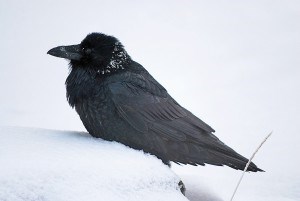
It’s Thursday, the day before my deadline for this piece, and armed with my camera and the smell of desperation I’m conducting my third and final stakeout of the Jasper Legion. I’m not hoping for a glimpse of the latest musician to grace the stage of Local Branch 31, I’m after a different sort of celebrity. I’m trying to track down the dancing ravens I’ve been hearing about—the ones that shake their tail feathers in front of the Legion’s mirrored glass. Sadly, I’ve been skunked, again.
WHY WHY WHY won’t they appear for me? Perhaps today it’s the gang of magpies marauding around the war cenotaph, taunting me with their squawks and making this whole area unfriendly air space for their more sophisticated cousins. Punks. Or maybe a watched raven never dances, at least not for me.
Luckily, there is the Internet, where I learned that watched ravens dance for everyone else. When I asked my local Facebook friends if anyone had seen them, within 20 minutes I had a full page of responses. It turns out this raven couple is well known, and they’ve been into mirror dancing for awhile.
“I saw them showing off some dance moves most of the summer on my way to work in the morning,” said Jessy Dion. “I couldn’t help but laugh and realize they were my first source of happiness of the day!”
Another friend said he’s seen them running back and forth along the length of the windows, watching themselves speed-waddle and squawking like they were, dare I say it, stark ravin’ mad.
Videos surfaced, confirming that one of the ravens’ favourite pass-times is hopping up and down and pecking at the glass in mid-air. They also like to puff-up and de-puff their feathers repeatedly. Eventually all this led to several people asking: “What the hell are they doing?”
Good question. To figure this out, I first wanted to understand if the ravens actually know if they are looking at themselves, or if they think two other good looking birds like to show up at the exact same time they do, ready to party.
Turns out, they know exactly who they’re looking at.
The corvid family of birds—ravens, magpies and crows—are self-aware, and can recognize themselves as unique individuals in a mirror. This ability has so far only been observed in humans (over the age of 18 months), apes, dolphins and elephants. Even cats and dogs can’t figure this one out.
If they understand the mirror is a reflection of themselves, then why the big performance? It looks an awful lot like the ravens are goofing around for their own amusement. Having fun. Playing. But is that really what they are doing?
Whether or not animals are capable of play is a subject filled with decades of study. A couple of hours down the research rabbit hole made me realize this is a hard question for scientists to answer.
Some animals look like they are playing, but in fact they’re practicing skills they may need as adults, or they’re trying to win a mate, or solve a problem. They may also be doing something that serves a function we don’t yet understand.
Complicating matters further, the act of play costs valuable calories. Extra energy can be hard to come by for animals, especially in the winter. If they are doing something simply for their own entertainment, it implies they are smart enough to understand their own energy requirements and trade-offs, and make a decision to enjoy themselves despite the costs.
This is entirely possible with the corvid family. Ravens, magpies and crows are among the smartest birds in the world, their intelligence now considered on par with animals like dolphins, elephants and apes. In recent studies they have demonstrated empathy for one another, and have been observed consoling each other after conflict. If they are capable of this, then why not play?
Ravens the world over have been observed “playing,” from sliding down snowy slopes on their backs, to flying upside down, to throwing shiny things around. Play is a way to safely experience and learn about the world. In some animals, like us, it helps develop the brain. It makes sense that play might allow ravens to hone their intelligence.
So where does that leave us with the Legion ravens?
If they’re hopping up and down to grow their brains and learn about the world, it’s sure taking them a long time to glean all they can from mirror games.
It seems pretty likely that they’re also just having a grand old time—you didn’t need me to tell you that.
But remember, the mirror reveals a lot. They may be watching us watch them, too.
Niki Wilson Special to the Fitzhugh
